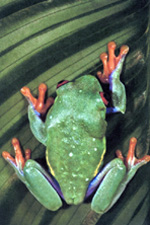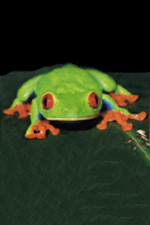|
||||
http://blepharopsis.deviantart.com |
Nutrition: • How a frog gets its food Like most other nocturnal tree frogs, the red-eyed tree frog goes with a ‘sit and wait' method for capturing its prey. The red-eyed tree frog uses its good eye sight and keen sense of smell to tell when ‘dinner' may be approaching. Once the frog spots its prey it flips out its elastic sticky tongue and then within seconds, pulls its prey back into its mouth. The frog's sticky tongue is covered with glands that secrete a sticky substance, making it possible for the frog to hold its pretty onto its long tongue long enough for the frog to get it into its mouth. The frog does have teeth, which are on the top of its jaw and are called vomarine and maxillary teeth. Those teeth, however, are only used for holding its prey in place and the frog's meal is always swallowed whole with out any chewing. • What a Tadpole Eats Very young tadpoles are primary consumers as well as filter feeders and feed mainly on algae. Once the tadpoles get larger and further along in its metamorphosis they start to eat small insects such as fruit flies and pinhead crickets, and flout beetles. • What an Adult Tree Frog Eats Adult red-eyed tree frogs eat a diet mainly consisting of any small fast moving invertebrate that will fit into its mouth, sometimes even small frogs! Mostly the red-eyed tree frog's diet consists of crickets, moths, flies, grasshoppers, and beetles. • Transportation of Food (Digestive System) The transportation of food is much like that of a human only simpler. After passing thorough the mouth the food goes to the stomach through the esophagus. From there it travels to the small intestine, the large digestive glands, the liver, and the pancreas, all along the way the nutrients are absorbed into the body by special ducts. The left over waste travels through the frog's kidneys and into the bladder from which the waste is expelled. • Circulation of Nutrients (Circulatory System) The frog's heart has three total chambers; two upper chambers (the right and left atrium) and a lower chamber (the ventricle). Oxygenated and deoxygenated blood is present in the heart at all times and sometimes, since the chambers aren't fully sectioned off from each other, mixing of the oxygenated and deoxygenated blood occurs. The arteries pump oxygenated blood away from the heart and the veins pump the now deoxygenated blood back to the heart. |
|||
|
||||
http://www.ryanphotographic.com/ Agalychnis%20callidrays.htm
|
||||


